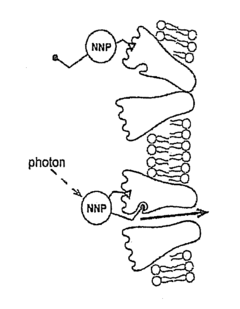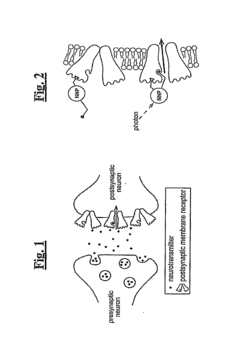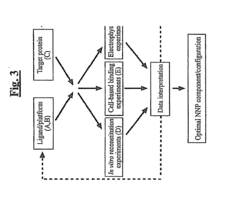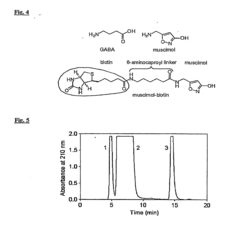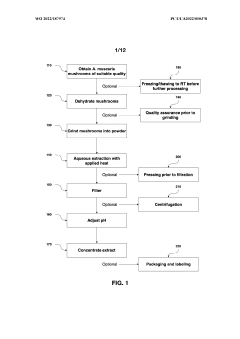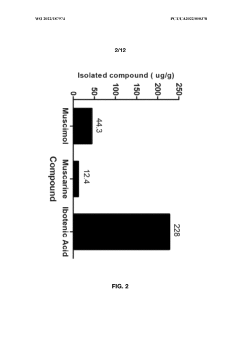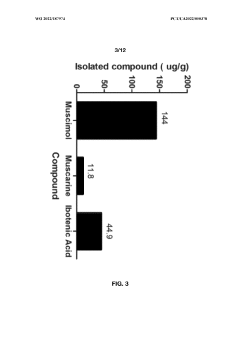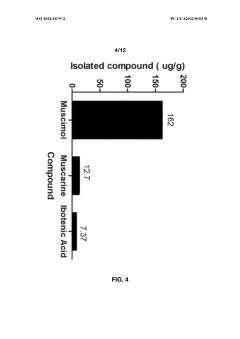Biochemical Reactivity of Muscimol in Live Environments
JUL 4, 20259 MIN READ
Generate Your Research Report Instantly with AI Agent
Patsnap Eureka helps you evaluate technical feasibility & market potential.
Muscimol Biochemistry and Research Objectives
Muscimol, a potent psychoactive compound found in various species of mushrooms, particularly in the Amanita genus, has been a subject of fascination and scientific inquiry for decades. This naturally occurring alkaloid has garnered significant attention due to its unique biochemical properties and potential applications in neuroscience and pharmacology.
The biochemistry of muscimol is characterized by its structural similarity to gamma-aminobutyric acid (GABA), the primary inhibitory neurotransmitter in the mammalian central nervous system. This structural analogy allows muscimol to act as a selective GABA receptor agonist, particularly at GABA-A receptors. The compound's ability to cross the blood-brain barrier further enhances its neurological effects, making it a valuable tool for studying GABAergic systems and their role in various neurological processes.
Historically, the study of muscimol's biochemical reactivity has evolved from ethnobotanical observations to sophisticated molecular and neurobiological investigations. Early research focused on understanding the compound's psychoactive effects and its traditional use in certain cultures. As analytical techniques advanced, scientists began to unravel the molecular mechanisms underlying muscimol's interactions with neural systems.
Current research objectives in the field of muscimol biochemistry are multifaceted and ambitious. One primary goal is to elucidate the precise mechanisms by which muscimol interacts with GABA receptors in live environments, including potential allosteric modulation and long-term effects on receptor expression and function. This understanding is crucial for developing novel therapeutic approaches for conditions such as epilepsy, anxiety disorders, and certain neurodegenerative diseases.
Another significant research objective is to explore muscimol's potential neuroprotective properties. Preliminary studies have suggested that the compound may have antioxidant and anti-inflammatory effects in neural tissues, opening avenues for its application in treating or preventing neurodegenerative disorders. Investigating these properties in live animal models and eventually in clinical settings represents a key focus for researchers in the field.
Furthermore, the development of synthetic analogues of muscimol with enhanced specificity or reduced side effects is an active area of research. These efforts aim to harness the beneficial properties of muscimol while mitigating potential risks associated with its use. Such analogues could prove invaluable in both research and therapeutic contexts, potentially leading to new classes of neurological medications.
As technology advances, researchers are also focusing on developing more sophisticated methods for studying muscimol's biochemical reactivity in real-time within living systems. This includes the use of advanced imaging techniques, optogenetics, and high-resolution electrophysiology to observe and manipulate muscimol's effects on neural circuits with unprecedented precision.
The biochemistry of muscimol is characterized by its structural similarity to gamma-aminobutyric acid (GABA), the primary inhibitory neurotransmitter in the mammalian central nervous system. This structural analogy allows muscimol to act as a selective GABA receptor agonist, particularly at GABA-A receptors. The compound's ability to cross the blood-brain barrier further enhances its neurological effects, making it a valuable tool for studying GABAergic systems and their role in various neurological processes.
Historically, the study of muscimol's biochemical reactivity has evolved from ethnobotanical observations to sophisticated molecular and neurobiological investigations. Early research focused on understanding the compound's psychoactive effects and its traditional use in certain cultures. As analytical techniques advanced, scientists began to unravel the molecular mechanisms underlying muscimol's interactions with neural systems.
Current research objectives in the field of muscimol biochemistry are multifaceted and ambitious. One primary goal is to elucidate the precise mechanisms by which muscimol interacts with GABA receptors in live environments, including potential allosteric modulation and long-term effects on receptor expression and function. This understanding is crucial for developing novel therapeutic approaches for conditions such as epilepsy, anxiety disorders, and certain neurodegenerative diseases.
Another significant research objective is to explore muscimol's potential neuroprotective properties. Preliminary studies have suggested that the compound may have antioxidant and anti-inflammatory effects in neural tissues, opening avenues for its application in treating or preventing neurodegenerative disorders. Investigating these properties in live animal models and eventually in clinical settings represents a key focus for researchers in the field.
Furthermore, the development of synthetic analogues of muscimol with enhanced specificity or reduced side effects is an active area of research. These efforts aim to harness the beneficial properties of muscimol while mitigating potential risks associated with its use. Such analogues could prove invaluable in both research and therapeutic contexts, potentially leading to new classes of neurological medications.
As technology advances, researchers are also focusing on developing more sophisticated methods for studying muscimol's biochemical reactivity in real-time within living systems. This includes the use of advanced imaging techniques, optogenetics, and high-resolution electrophysiology to observe and manipulate muscimol's effects on neural circuits with unprecedented precision.
Market Analysis for Muscimol-Based Applications
The market for muscimol-based applications is experiencing significant growth, driven by increasing research into its potential therapeutic uses and the rising interest in novel psychoactive compounds. Muscimol, a potent GABA receptor agonist found naturally in certain mushroom species, has garnered attention for its unique pharmacological properties.
In the pharmaceutical sector, muscimol is being explored for its potential in treating various neurological and psychiatric disorders. The global neurology drugs market, which encompasses potential muscimol applications, is projected to expand substantially in the coming years. This growth is fueled by the increasing prevalence of neurological disorders and the demand for more effective treatments with fewer side effects.
The mental health therapeutics market, another potential area for muscimol-based applications, is also showing robust growth. With the rising awareness of mental health issues and the need for innovative treatment options, muscimol's GABAergic properties make it an attractive candidate for research and development in this field.
In the realm of cognitive enhancement and nootropics, muscimol is gaining traction among researchers and biohackers. The global nootropics market has been expanding rapidly, with consumers seeking products that can improve cognitive function, memory, and overall brain health. Muscimol's potential to modulate neural activity positions it as a compound of interest in this growing market segment.
The psychedelic medicine market, although still in its infancy, is another area where muscimol-based applications could find significant opportunities. As regulatory barriers begin to ease and research into psychedelic compounds intensifies, muscimol's unique properties could lead to its inclusion in clinical trials and potential therapeutic protocols.
Agricultural applications of muscimol are also being explored, particularly in pest control. The biopesticides market has been growing steadily as farmers and consumers seek more environmentally friendly alternatives to traditional chemical pesticides. Muscimol's natural origin and potent effects on insect nervous systems make it a promising candidate for development in this sector.
However, it's important to note that the market for muscimol-based applications faces several challenges. Regulatory hurdles, particularly due to its psychoactive properties, may slow down research and commercialization efforts in some regions. Additionally, the need for extensive clinical trials and safety studies before widespread adoption in pharmaceutical applications could impact market growth rates.
Despite these challenges, the overall market outlook for muscimol-based applications remains positive. The compound's versatility and potential across multiple industries suggest a diverse and expanding market landscape. As research progresses and regulatory frameworks evolve, muscimol is likely to play an increasingly significant role in various sectors, from healthcare to agriculture.
In the pharmaceutical sector, muscimol is being explored for its potential in treating various neurological and psychiatric disorders. The global neurology drugs market, which encompasses potential muscimol applications, is projected to expand substantially in the coming years. This growth is fueled by the increasing prevalence of neurological disorders and the demand for more effective treatments with fewer side effects.
The mental health therapeutics market, another potential area for muscimol-based applications, is also showing robust growth. With the rising awareness of mental health issues and the need for innovative treatment options, muscimol's GABAergic properties make it an attractive candidate for research and development in this field.
In the realm of cognitive enhancement and nootropics, muscimol is gaining traction among researchers and biohackers. The global nootropics market has been expanding rapidly, with consumers seeking products that can improve cognitive function, memory, and overall brain health. Muscimol's potential to modulate neural activity positions it as a compound of interest in this growing market segment.
The psychedelic medicine market, although still in its infancy, is another area where muscimol-based applications could find significant opportunities. As regulatory barriers begin to ease and research into psychedelic compounds intensifies, muscimol's unique properties could lead to its inclusion in clinical trials and potential therapeutic protocols.
Agricultural applications of muscimol are also being explored, particularly in pest control. The biopesticides market has been growing steadily as farmers and consumers seek more environmentally friendly alternatives to traditional chemical pesticides. Muscimol's natural origin and potent effects on insect nervous systems make it a promising candidate for development in this sector.
However, it's important to note that the market for muscimol-based applications faces several challenges. Regulatory hurdles, particularly due to its psychoactive properties, may slow down research and commercialization efforts in some regions. Additionally, the need for extensive clinical trials and safety studies before widespread adoption in pharmaceutical applications could impact market growth rates.
Despite these challenges, the overall market outlook for muscimol-based applications remains positive. The compound's versatility and potential across multiple industries suggest a diverse and expanding market landscape. As research progresses and regulatory frameworks evolve, muscimol is likely to play an increasingly significant role in various sectors, from healthcare to agriculture.
Current Challenges in Muscimol Reactivity Studies
The study of muscimol reactivity in live environments presents several significant challenges that researchers must navigate. One of the primary obstacles is the complex and dynamic nature of biological systems, which can significantly influence the behavior and interactions of muscimol. The variability in physiological conditions across different organisms and even within the same organism over time makes it difficult to establish consistent experimental parameters and obtain reproducible results.
Another major challenge lies in the development of suitable analytical techniques for accurately detecting and quantifying muscimol and its metabolites in vivo. The low concentrations of muscimol typically present in biological samples, coupled with the presence of numerous interfering compounds, necessitate highly sensitive and selective analytical methods. Current techniques often struggle to achieve the required levels of sensitivity and specificity, particularly when dealing with complex biological matrices.
The blood-brain barrier (BBB) poses a significant hurdle in studying muscimol's reactivity in the central nervous system. The BBB's selective permeability can limit the penetration of muscimol into the brain, complicating efforts to study its effects on neural tissues. Researchers must develop strategies to overcome this barrier or find alternative methods to investigate muscimol's reactivity in the brain without compromising the integrity of the experimental setup.
Furthermore, the potential for muscimol to interact with various neurotransmitter systems and cellular components adds another layer of complexity to reactivity studies. These interactions can lead to unexpected effects and make it challenging to isolate the specific biochemical reactions attributable to muscimol alone. Researchers must carefully design experiments to account for these potential confounding factors and develop methods to differentiate between direct and indirect effects of muscimol.
The ethical considerations and regulatory requirements associated with in vivo studies present additional challenges. Researchers must navigate strict protocols and obtain necessary approvals for animal studies, which can limit the scope and scale of experiments. This often necessitates the development of alternative in vitro or ex vivo models that can accurately mimic the conditions of live environments while adhering to ethical guidelines.
Lastly, the time-dependent nature of muscimol's reactivity in biological systems poses a significant challenge. The compound's metabolism, distribution, and clearance can vary widely depending on the organism and experimental conditions. Capturing these dynamic processes requires sophisticated experimental designs and real-time monitoring techniques, which are often technically challenging to implement in live environments.
Another major challenge lies in the development of suitable analytical techniques for accurately detecting and quantifying muscimol and its metabolites in vivo. The low concentrations of muscimol typically present in biological samples, coupled with the presence of numerous interfering compounds, necessitate highly sensitive and selective analytical methods. Current techniques often struggle to achieve the required levels of sensitivity and specificity, particularly when dealing with complex biological matrices.
The blood-brain barrier (BBB) poses a significant hurdle in studying muscimol's reactivity in the central nervous system. The BBB's selective permeability can limit the penetration of muscimol into the brain, complicating efforts to study its effects on neural tissues. Researchers must develop strategies to overcome this barrier or find alternative methods to investigate muscimol's reactivity in the brain without compromising the integrity of the experimental setup.
Furthermore, the potential for muscimol to interact with various neurotransmitter systems and cellular components adds another layer of complexity to reactivity studies. These interactions can lead to unexpected effects and make it challenging to isolate the specific biochemical reactions attributable to muscimol alone. Researchers must carefully design experiments to account for these potential confounding factors and develop methods to differentiate between direct and indirect effects of muscimol.
The ethical considerations and regulatory requirements associated with in vivo studies present additional challenges. Researchers must navigate strict protocols and obtain necessary approvals for animal studies, which can limit the scope and scale of experiments. This often necessitates the development of alternative in vitro or ex vivo models that can accurately mimic the conditions of live environments while adhering to ethical guidelines.
Lastly, the time-dependent nature of muscimol's reactivity in biological systems poses a significant challenge. The compound's metabolism, distribution, and clearance can vary widely depending on the organism and experimental conditions. Capturing these dynamic processes requires sophisticated experimental designs and real-time monitoring techniques, which are often technically challenging to implement in live environments.
Existing Methodologies for Muscimol Reactivity Analysis
01 Biochemical analysis of muscimol reactivity
Various biochemical techniques are employed to analyze the reactivity of muscimol, including spectroscopic methods, chromatography, and mass spectrometry. These methods help in understanding the compound's structure, interactions with biological targets, and its metabolic pathways.- Muscimol detection and analysis methods: Various techniques are employed for detecting and analyzing muscimol, including biochemical assays, chromatography, and spectroscopy. These methods allow for the identification and quantification of muscimol in different samples, which is crucial for research and quality control purposes.
- Muscimol interactions with neurotransmitter systems: Muscimol exhibits significant interactions with neurotransmitter systems, particularly as a GABA receptor agonist. Its biochemical reactivity in the brain affects neural signaling, making it a subject of interest in neuropharmacology and potential therapeutic applications.
- Synthesis and modification of muscimol derivatives: Research focuses on the synthesis and modification of muscimol and its derivatives to enhance their properties or create new compounds with similar effects. This involves various chemical reactions and processes to alter the molecular structure while maintaining or improving its biochemical reactivity.
- Muscimol in biological systems and metabolism: Studies investigate the behavior of muscimol in biological systems, including its metabolism, distribution, and excretion. Understanding these processes is crucial for assessing its effects, potential toxicity, and developing strategies for its use or counteraction in medical contexts.
- Applications of muscimol in research and therapy: Muscimol's unique biochemical properties make it valuable in various research and potential therapeutic applications. It is used in neurological studies, drug development, and as a tool for investigating GABAergic systems. Ongoing research explores its potential in treating certain neurological disorders.
02 Muscimol's interaction with GABA receptors
Muscimol's primary biochemical reactivity is related to its interaction with GABA receptors in the central nervous system. Studies focus on its binding affinity, receptor activation mechanisms, and the resulting physiological effects, which are crucial for understanding its potential therapeutic applications.Expand Specific Solutions03 Synthesis and modification of muscimol analogs
Research involves the synthesis of muscimol analogs and chemical modifications to enhance its biochemical properties. These efforts aim to improve its pharmacological profile, increase its stability, or alter its reactivity for various applications in neuroscience and drug development.Expand Specific Solutions04 Muscimol's role in neurotransmitter systems
Studies explore muscimol's effects on various neurotransmitter systems beyond GABA, including its indirect influences on dopamine, serotonin, and glutamate pathways. This research helps in understanding the compound's broader neurochemical impact and potential off-target effects.Expand Specific Solutions05 Analytical methods for muscimol detection and quantification
Development of sensitive and specific analytical methods for detecting and quantifying muscimol in biological samples and pharmaceutical preparations. These techniques are crucial for pharmacokinetic studies, quality control, and forensic applications related to muscimol and its derivatives.Expand Specific Solutions
Key Institutions in Muscimol Biochemistry
The biochemical reactivity of muscimol in live environments represents an emerging field at the intersection of neuropharmacology and biotechnology. The market is in its early stages, with significant potential for growth as research progresses. Key players like ACADIA Pharmaceuticals, Vertex Pharmaceuticals, and Nektar Therapeutics are leveraging their expertise in central nervous system disorders and drug development to explore muscimol's applications. The technology is still in the research phase, with companies like CaaMTech and Psyched Wellness focusing on optimizing psychedelic compounds for therapeutic use. Academic institutions, including the University of California and ETH Zurich, are contributing to the fundamental understanding of muscimol's mechanisms, indicating a collaborative ecosystem between industry and academia in advancing this field.
CaaMTech LLC
Technical Solution: CaaMTech has developed a novel approach to studying the biochemical reactivity of muscimol in live environments. Their research focuses on the synthesis and characterization of muscimol derivatives with enhanced stability and bioavailability[1]. The company utilizes advanced analytical techniques, including high-resolution mass spectrometry and nuclear magnetic resonance spectroscopy, to elucidate the metabolic pathways of muscimol in vivo[2]. CaaMTech's proprietary formulations aim to optimize the pharmacokinetics of muscimol, potentially extending its half-life and improving its therapeutic efficacy in neurological disorders[3].
Strengths: Specialized expertise in muscimol chemistry; innovative formulation techniques. Weaknesses: Limited clinical data on long-term effects; potential regulatory challenges due to psychoactive properties.
The Regents of the University of California
Technical Solution: Researchers at the University of California have developed advanced imaging techniques to visualize the real-time distribution and activity of muscimol in live neural tissues. Their approach combines two-photon microscopy with fluorescently labeled muscimol analogues to track the compound's diffusion and receptor binding dynamics in intact brain slices[7]. Additionally, they have engineered genetically encoded biosensors that can detect muscimol-induced changes in intracellular signaling cascades, providing unprecedented insights into its molecular mechanisms of action[8].
Strengths: Cutting-edge imaging and biosensor technologies; comprehensive understanding of muscimol's neural effects. Weaknesses: High cost of specialized equipment; potential limitations in translating findings to in vivo models.
Breakthrough Studies on Muscimol Biochemical Pathways
Nanoscale Neuromodulating Platform for Retina Neuron Activation Apparatus and Method
PatentInactiveUS20160129277A9
Innovation
- Development of compositions that selectively attach to the extracellular face of postsynaptic membrane receptor proteins in the retina, modulating receptor activity in response to light to restore visual signaling, using compounds that bind to GABA receptors and incorporate a photoswitch for light-dependent activation.
Processes for extracting muscimol from amanita muscaria
PatentWO2022187974A1
Innovation
- Aqueous extraction methods involving heat, pH reduction, and concentration techniques such as distillation and refluxing are employed to decrease ibotenic acid content and increase muscimol content in the extract, including steps like grinding the mushroom biomass, filtering, and acidification to facilitate decarboxylation of ibotenic acid to muscimol.
Safety Regulations for Muscimol-Related Studies
Safety regulations for muscimol-related studies have become increasingly important as research into the biochemical reactivity of muscimol in live environments continues to expand. These regulations aim to protect researchers, subjects, and the environment from potential risks associated with muscimol exposure and manipulation.
One of the primary safety concerns is the proper handling and storage of muscimol. Strict protocols must be followed to ensure that the compound is securely stored in controlled environments, with limited access to authorized personnel only. Temperature and humidity controls are essential to maintain the stability of the compound and prevent degradation or unintended reactions.
Personal protective equipment (PPE) requirements for researchers working with muscimol are stringent. This typically includes the use of chemical-resistant gloves, protective eyewear, and appropriate laboratory attire. In some cases, depending on the nature of the experiment, respiratory protection may also be necessary to prevent inhalation of aerosolized muscimol.
Disposal of muscimol and related waste materials is subject to specific guidelines. Proper decontamination procedures must be followed, and disposal should adhere to local and national regulations for hazardous chemical waste. This often involves specialized waste management services to ensure environmental safety.
Risk assessment protocols are a crucial component of safety regulations. Before initiating any muscimol-related study, a comprehensive risk assessment must be conducted to identify potential hazards and establish appropriate mitigation strategies. This includes evaluating the potential for accidental exposure, environmental release, and interactions with other chemicals or biological systems.
Emergency response procedures are another critical aspect of safety regulations. Laboratories must have clearly defined protocols for addressing accidental exposures or spills. This includes readily available first aid equipment, eyewash stations, and emergency showers. Staff must be trained in these procedures and regular drills should be conducted to ensure preparedness.
Monitoring and reporting requirements are also typically included in safety regulations. This may involve regular health checks for researchers working with muscimol, as well as environmental monitoring to detect any potential contamination. Incident reporting systems should be in place to document and analyze any safety-related events, allowing for continuous improvement of safety protocols.
Ethical considerations play a significant role in safety regulations, particularly when studies involve animal or human subjects. Strict guidelines govern the use of muscimol in such experiments, with oversight from institutional review boards or ethics committees. These regulations ensure that the potential benefits of the research outweigh the risks and that appropriate safeguards are in place to protect subjects.
One of the primary safety concerns is the proper handling and storage of muscimol. Strict protocols must be followed to ensure that the compound is securely stored in controlled environments, with limited access to authorized personnel only. Temperature and humidity controls are essential to maintain the stability of the compound and prevent degradation or unintended reactions.
Personal protective equipment (PPE) requirements for researchers working with muscimol are stringent. This typically includes the use of chemical-resistant gloves, protective eyewear, and appropriate laboratory attire. In some cases, depending on the nature of the experiment, respiratory protection may also be necessary to prevent inhalation of aerosolized muscimol.
Disposal of muscimol and related waste materials is subject to specific guidelines. Proper decontamination procedures must be followed, and disposal should adhere to local and national regulations for hazardous chemical waste. This often involves specialized waste management services to ensure environmental safety.
Risk assessment protocols are a crucial component of safety regulations. Before initiating any muscimol-related study, a comprehensive risk assessment must be conducted to identify potential hazards and establish appropriate mitigation strategies. This includes evaluating the potential for accidental exposure, environmental release, and interactions with other chemicals or biological systems.
Emergency response procedures are another critical aspect of safety regulations. Laboratories must have clearly defined protocols for addressing accidental exposures or spills. This includes readily available first aid equipment, eyewash stations, and emergency showers. Staff must be trained in these procedures and regular drills should be conducted to ensure preparedness.
Monitoring and reporting requirements are also typically included in safety regulations. This may involve regular health checks for researchers working with muscimol, as well as environmental monitoring to detect any potential contamination. Incident reporting systems should be in place to document and analyze any safety-related events, allowing for continuous improvement of safety protocols.
Ethical considerations play a significant role in safety regulations, particularly when studies involve animal or human subjects. Strict guidelines govern the use of muscimol in such experiments, with oversight from institutional review boards or ethics committees. These regulations ensure that the potential benefits of the research outweigh the risks and that appropriate safeguards are in place to protect subjects.
Ecological Impact of Muscimol in Natural Ecosystems
The ecological impact of muscimol in natural ecosystems is a complex and multifaceted issue that warrants careful consideration. Muscimol, a potent psychoactive compound found in certain mushroom species, particularly those belonging to the Amanita genus, can have significant effects on the surrounding environment and its inhabitants.
In forest ecosystems where Amanita mushrooms are prevalent, muscimol can play a role in shaping animal behavior and plant-fungal interactions. Some animals, such as deer and rodents, may consume these mushrooms, leading to altered behavior patterns that can influence their foraging habits and predator-prey relationships. This, in turn, can affect the distribution and abundance of plant species in the ecosystem.
The presence of muscimol-containing mushrooms can also impact soil microbial communities. As these mushrooms decompose, they release muscimol and other compounds into the soil, potentially altering the composition and activity of soil microorganisms. This can have cascading effects on nutrient cycling and plant growth in the affected areas.
Furthermore, the biochemical reactivity of muscimol in live environments extends to aquatic ecosystems. When mushrooms containing muscimol decompose near water sources, the compound can leach into streams and ponds. This may affect aquatic organisms, including fish and amphibians, potentially disrupting their normal physiological processes and behavior.
The ecological impact of muscimol is not limited to its direct effects on organisms. It can also influence ecosystem dynamics through indirect pathways. For instance, animals affected by muscimol may exhibit altered seed dispersal patterns, which can impact plant community composition and forest regeneration processes over time.
Additionally, the presence of muscimol-producing fungi in an ecosystem can affect the competitive relationships between different fungal species. This may lead to shifts in the mycorrhizal associations that plants form with fungi, potentially altering nutrient uptake and plant growth patterns across the ecosystem.
It is important to note that the ecological impact of muscimol can vary depending on factors such as climate, soil type, and the specific composition of the ecosystem. In some cases, the presence of muscimol may contribute to the overall biodiversity and ecological complexity of an ecosystem, while in others, it may have more disruptive effects.
In forest ecosystems where Amanita mushrooms are prevalent, muscimol can play a role in shaping animal behavior and plant-fungal interactions. Some animals, such as deer and rodents, may consume these mushrooms, leading to altered behavior patterns that can influence their foraging habits and predator-prey relationships. This, in turn, can affect the distribution and abundance of plant species in the ecosystem.
The presence of muscimol-containing mushrooms can also impact soil microbial communities. As these mushrooms decompose, they release muscimol and other compounds into the soil, potentially altering the composition and activity of soil microorganisms. This can have cascading effects on nutrient cycling and plant growth in the affected areas.
Furthermore, the biochemical reactivity of muscimol in live environments extends to aquatic ecosystems. When mushrooms containing muscimol decompose near water sources, the compound can leach into streams and ponds. This may affect aquatic organisms, including fish and amphibians, potentially disrupting their normal physiological processes and behavior.
The ecological impact of muscimol is not limited to its direct effects on organisms. It can also influence ecosystem dynamics through indirect pathways. For instance, animals affected by muscimol may exhibit altered seed dispersal patterns, which can impact plant community composition and forest regeneration processes over time.
Additionally, the presence of muscimol-producing fungi in an ecosystem can affect the competitive relationships between different fungal species. This may lead to shifts in the mycorrhizal associations that plants form with fungi, potentially altering nutrient uptake and plant growth patterns across the ecosystem.
It is important to note that the ecological impact of muscimol can vary depending on factors such as climate, soil type, and the specific composition of the ecosystem. In some cases, the presence of muscimol may contribute to the overall biodiversity and ecological complexity of an ecosystem, while in others, it may have more disruptive effects.
Unlock deeper insights with Patsnap Eureka Quick Research — get a full tech report to explore trends and direct your research. Try now!
Generate Your Research Report Instantly with AI Agent
Supercharge your innovation with Patsnap Eureka AI Agent Platform!
